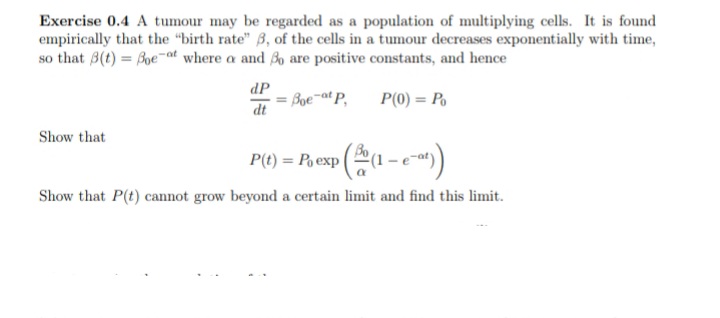Exercise 0.4 A tumour may be regarded as a population of multiplying cells. It is found empirically that the "birth rate" 8, of the cells in a tumour decreases exponentially with time, so that 3(t) = Boe af where a and are positive constants, and hence dP = Boe-a P, P(0) = P dt Show that P() = R,esp 1 - c) %3D Show that P(t) cannot grow beyond a certain limit and find this limit.
Exercise 0.4 A tumour may be regarded as a population of multiplying cells. It is found empirically that the "birth rate" 8, of the cells in a tumour decreases exponentially with time, so that 3(t) = Boe af where a and are positive constants, and hence dP = Boe-a P, P(0) = P dt Show that P() = R,esp 1 - c) %3D Show that P(t) cannot grow beyond a certain limit and find this limit.
Chapter5: Exponential And Logarithmic Functions
Section5.5: Exponential And Logarithmic Models
Problem 30E: The table shows the mid-year populations (in millions) of five countries in 2015 and the projected...
Related questions
Question

Transcribed Image Text:Exercise 0.4 A tumour may be regarded as a population of multiplying cells. It is found
empirically that the "birth rate" 3, of the cells in a tumour decreases exponentially with time,
so that 3(t) = Boe-at where a and 3o are positive constants, and hence
dP
Boe-at P,
P(0) = Po
dt
Show that
P(t) = P, exp (1 -e)
Show that P(t) cannot grow beyond a certain limit and find this limit.
Expert Solution
This question has been solved!
Explore an expertly crafted, step-by-step solution for a thorough understanding of key concepts.
Step by step
Solved in 2 steps

Recommended textbooks for you


Algebra & Trigonometry with Analytic Geometry
Algebra
ISBN:
9781133382119
Author:
Swokowski
Publisher:
Cengage


Algebra & Trigonometry with Analytic Geometry
Algebra
ISBN:
9781133382119
Author:
Swokowski
Publisher:
Cengage